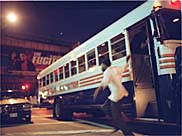|
 |
|
Esta página no está disponible en español. THE NEW YORK TIMESLife on Freedom StreetBy ADAM FIFIELD
December 23, 2001
What to do? The question confronts released inmates as soon as they bounce off the Rikers bus. Some are determined to go straight, but the street offers powerful lures, like drugs and prostitution. AT 5:15 a.m. on a Monday in early December, 30 men bounded off a bus in Queens Plaza, many of them whooping and cheering. Some cursed the bus or made gestures at it. Clutching translucent plastic bags bulging with their possessions, they looked around, drawing in the surroundings: the vacant, shadowy streets, the Citibank Tower looming on the murky horizon, the aluminum coffee cart glinting under the jaundiced glow of street lamps. The men, dressed in old, rumpled clothes, preferred that no one know where they had come from. But the white and blue bus gave them away. Like a warning label, its side announced in loud orange letters: "New York City Correction." Every weekday about 5 a.m., such a bus travels from the Rikers Island jail to Jackson Avenue near Queens Plaza South and disgorges a boisterous procession of up to 50 inmates who have just completed their sentences. As this day's bus rumbled off, most of the men trudged toward the subway or the two 24-hour doughnut shops, which share a block with a strip club, a deli and sometimes, a couple of prostitutes and drug dealers. Other inmates, like Nelson Marrero, stood silent and wide-eyed. There were wreaths and gold tinsel at one of the doughnut stores, signs of the season of warmth and giving. Indeed, the morning had already delivered a big gift to these men, the gift of freedom. But the scene was dreary, and so were many of the men's prospects. As for the gift they had just received, it came wrapped in temptation. Mr. Marrero, tall and gaunt and clutching a Bible, looked like an ascetic who had wandered into the wrong neighborhood. Unlike the other inmates, he had no bag of clothes. "I tell you the truth," said Mr. Marrero, a Puerto Rican who speaks rudimentary English. "Me in the street." He meant he was homeless. Then his face split into a wide smile. "This is my last time," he said, alluding to his stay at Rikers and pointing to his Bible. "I got my God now." Despite his almost monastic appearance, Mr. Marrero has a considerable record, including robbery and criminal tampering with water and gas meters. He has done time at several places; this was his third stay at Rikers. The problem this time, he said, was that he had been fired from his job as a handyman for a landlord after his tools were stolen. So, he said, he had broken into some public pay phones to steal quarters and been caught by the police. At Donuts Unlimited, Mr. Marrero sipped a cup of coffee and said he wanted to fly back to his family in Puerto Rico. But he saw only long odds. "I don't got nothing," he said. "No money. What am I going to do? How am I going to get money? You know how much a ticket costs to Puerto Rico? $290. Where am I going to get it? Maybe tomorrow me come back to jail." Then with a jolt of enthusiasm, he ticked off his job skills. "You see that floor? I can do that. You see that dropped ceiling? I can do dropped ceiling. You see the lights? I can do electricity." Around 6 a.m., Mr. Marrero fished out of his pocket the MetroCard the Correction Department had given him. He was going to 116th Street and Second Avenue to look up a friend who worked at a Laundromat and ask him for money. The Rikers drop-off spot – call it Freedom Street – is where, since 1985, inmates have gotten their first taste of liberty. Its faces include relatives and friends, anxiously waiting; bus drivers witnessing emotional scenes; and merchants peddling goods both legal and illegal. Its five blocks have seen dramatic reunions and desperate transactions. For Rikers inmates, the street is also a crucible. "It's in the first few minutes at Queens Plaza that they make a lot of decisions that will affect the next six months to a year of their life," said Jennifer Wynn, author of "Inside Rikers: Stories From the World's Largest Penal Colony" (St. Martin's Press, 2001), an examination of inmates' struggles in and out of jail. The area is marked by contrasts and rapid change. A few blocks from the doughnut shops is Silvercup Studios, a formidable blond building where "Sex and the City" and "The Sopranos" are taped. On the other side of the subway tracks sit the Queensbridge Houses, sprawling over several blocks. The houses are the country's largest public housing complex.
|

 (PHOTO: Edward Keating/The New York Times)
(PHOTO: Edward Keating/The New York Times)